Sushant Gautam
Kvasir-VQA-x1: A Multimodal Dataset for Medical Reasoning and Robust MedVQA in Gastrointestinal Endoscopy
Jun 11, 2025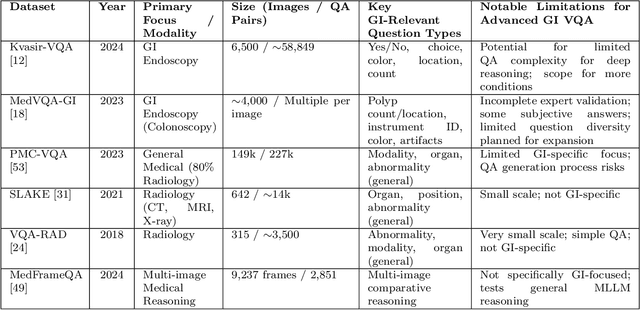
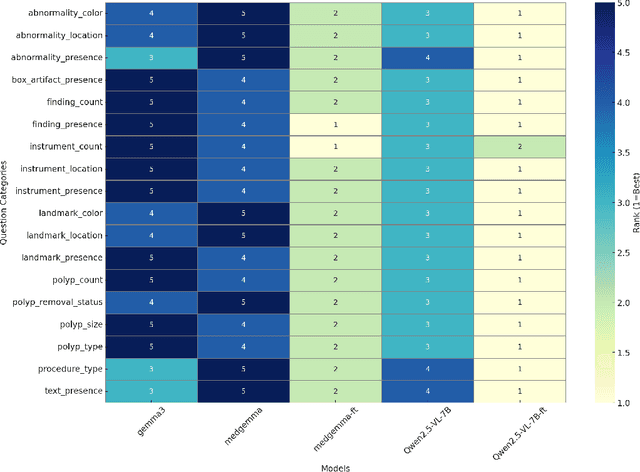
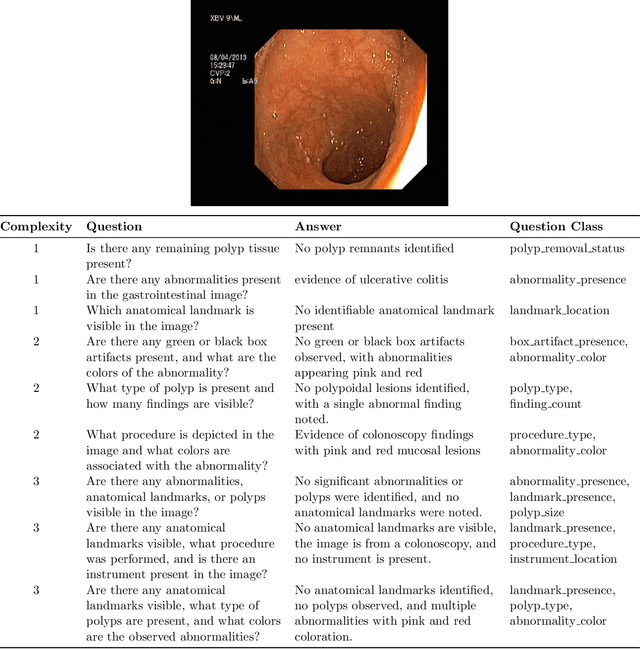
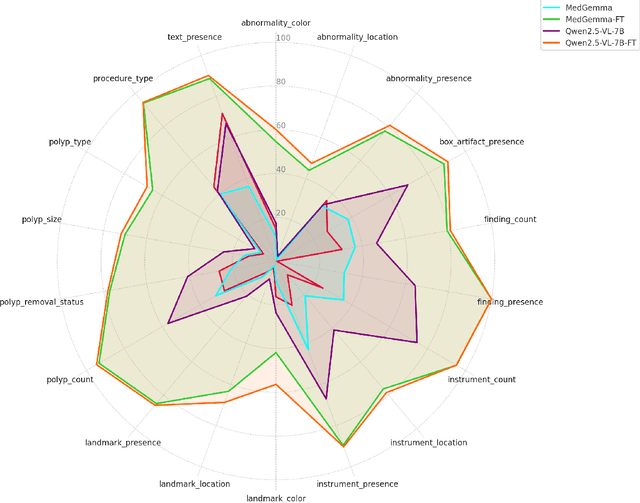
Abstract:Medical Visual Question Answering (MedVQA) is a promising field for developing clinical decision support systems, yet progress is often limited by the available datasets, which can lack clinical complexity and visual diversity. To address these gaps, we introduce Kvasir-VQA-x1, a new, large-scale dataset for gastrointestinal (GI) endoscopy. Our work significantly expands upon the original Kvasir-VQA by incorporating 159,549 new question-answer pairs that are designed to test deeper clinical reasoning. We developed a systematic method using large language models to generate these questions, which are stratified by complexity to better assess a model's inference capabilities. To ensure our dataset prepares models for real-world clinical scenarios, we have also introduced a variety of visual augmentations that mimic common imaging artifacts. The dataset is structured to support two main evaluation tracks: one for standard VQA performance and another to test model robustness against these visual perturbations. By providing a more challenging and clinically relevant benchmark, Kvasir-VQA-x1 aims to accelerate the development of more reliable and effective multimodal AI systems for use in clinical settings. The dataset is fully accessible and adheres to FAIR data principles, making it a valuable resource for the wider research community. Code and data: https://github.com/Simula/Kvasir-VQA-x1 and https://huggingface.co/datasets/SimulaMet/Kvasir-VQA-x1
SoccerChat: Integrating Multimodal Data for Enhanced Soccer Game Understanding
May 22, 2025Abstract:The integration of artificial intelligence in sports analytics has transformed soccer video understanding, enabling real-time, automated insights into complex game dynamics. Traditional approaches rely on isolated data streams, limiting their effectiveness in capturing the full context of a match. To address this, we introduce SoccerChat, a multimodal conversational AI framework that integrates visual and textual data for enhanced soccer video comprehension. Leveraging the extensive SoccerNet dataset, enriched with jersey color annotations and automatic speech recognition (ASR) transcripts, SoccerChat is fine-tuned on a structured video instruction dataset to facilitate accurate game understanding, event classification, and referee decision making. We benchmark SoccerChat on action classification and referee decision-making tasks, demonstrating its performance in general soccer event comprehension while maintaining competitive accuracy in referee decision making. Our findings highlight the importance of multimodal integration in advancing soccer analytics, paving the way for more interactive and explainable AI-driven sports analysis. https://github.com/simula/SoccerChat
Point, Detect, Count: Multi-Task Medical Image Understanding with Instruction-Tuned Vision-Language Models
May 22, 2025Abstract:We investigate fine-tuning Vision-Language Models (VLMs) for multi-task medical image understanding, focusing on detection, localization, and counting of findings in medical images. Our objective is to evaluate whether instruction-tuned VLMs can simultaneously improve these tasks, with the goal of enhancing diagnostic accuracy and efficiency. Using MedMultiPoints, a multimodal dataset with annotations from endoscopy (polyps and instruments) and microscopy (sperm cells), we reformulate each task into instruction-based prompts suitable for vision-language reasoning. We fine-tune Qwen2.5-VL-7B-Instruct using Low-Rank Adaptation (LoRA) across multiple task combinations. Results show that multi-task training improves robustness and accuracy. For example, it reduces the Count Mean Absolute Error (MAE) and increases Matching Accuracy in the Counting + Pointing task. However, trade-offs emerge, such as more zero-case point predictions, indicating reduced reliability in edge cases despite overall performance gains. Our study highlights the potential of adapting general-purpose VLMs to specialized medical tasks via prompt-driven fine-tuning. This approach mirrors clinical workflows, where radiologists simultaneously localize, count, and describe findings - demonstrating how VLMs can learn composite diagnostic reasoning patterns. The model produces interpretable, structured outputs, offering a promising step toward explainable and versatile medical AI. Code, model weights, and scripts will be released for reproducibility at https://github.com/simula/PointDetectCount.
Prompt to Polyp: Medical Text-Conditioned Image Synthesis with Diffusion Models
May 12, 2025Abstract:The generation of realistic medical images from text descriptions has significant potential to address data scarcity challenges in healthcare AI while preserving patient privacy. This paper presents a comprehensive study of text-to-image synthesis in the medical domain, comparing two distinct approaches: (1) fine-tuning large pre-trained latent diffusion models and (2) training small, domain-specific models. We introduce a novel model named MSDM, an optimized architecture based on Stable Diffusion that integrates a clinical text encoder, variational autoencoder, and cross-attention mechanisms to better align medical text prompts with generated images. Our study compares two approaches: fine-tuning large pre-trained models (FLUX, Kandinsky) versus training compact domain-specific models (MSDM). Evaluation across colonoscopy (MedVQA-GI) and radiology (ROCOv2) datasets reveals that while large models achieve higher fidelity, our optimized MSDM delivers comparable quality with lower computational costs. Quantitative metrics and qualitative evaluations by medical experts reveal strengths and limitations of each approach.
Prompt to Polyp: Clinically-Aware Medical Image Synthesis with Diffusion Models
May 08, 2025Abstract:The generation of realistic medical images from text descriptions has significant potential to address data scarcity challenges in healthcare AI while preserving patient privacy. This paper presents a comprehensive study of text-to-image synthesis in the medical domain, comparing two distinct approaches: (1) fine-tuning large pre-trained latent diffusion models and (2) training small, domain-specific models. We introduce a novel model named MSDM, an optimized architecture based on Stable Diffusion that integrates a clinical text encoder, variational autoencoder, and cross-attention mechanisms to better align medical text prompts with generated images. Our study compares two approaches: fine-tuning large pre-trained models (FLUX, Kandinsky) versus training compact domain-specific models (MSDM). Evaluation across colonoscopy (MedVQA-GI) and radiology (ROCOv2) datasets reveals that while large models achieve higher fidelity, our optimized MSDM delivers comparable quality with lower computational costs. Quantitative metrics and qualitative evaluations by medical experts reveal strengths and limitations of each approach.
X-DECODE: EXtreme Deblurring with Curriculum Optimization and Domain Equalization
Apr 10, 2025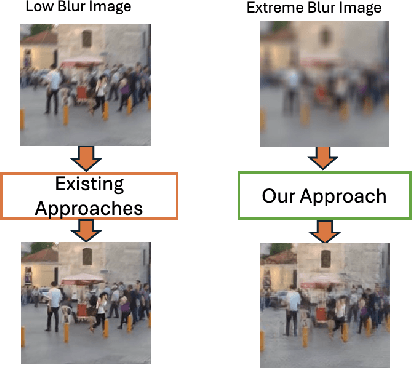
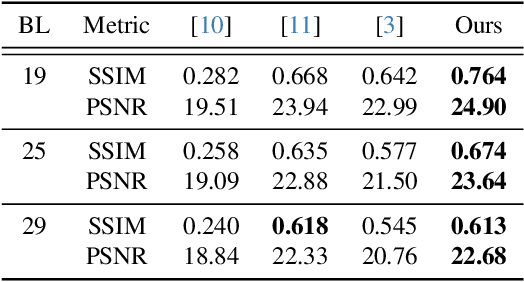
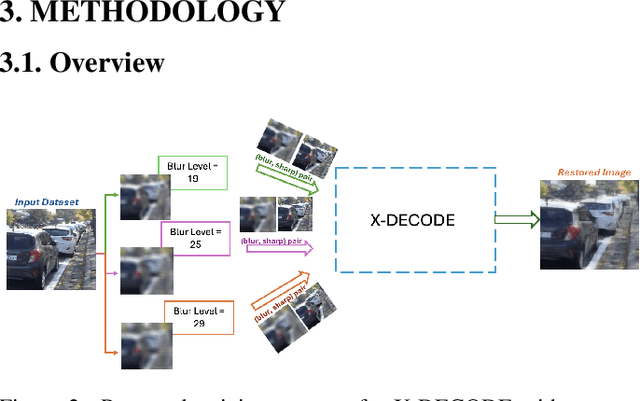
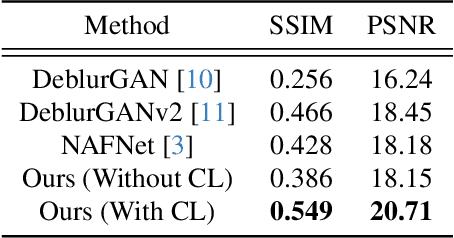
Abstract:Restoring severely blurred images remains a significant challenge in computer vision, impacting applications in autonomous driving, medical imaging, and photography. This paper introduces a novel training strategy based on curriculum learning to improve the robustness of deep learning models for extreme image deblurring. Unlike conventional approaches that train on only low to moderate blur levels, our method progressively increases the difficulty by introducing images with higher blur severity over time, allowing the model to adapt incrementally. Additionally, we integrate perceptual and hinge loss during training to enhance fine detail restoration and improve training stability. We experimented with various curriculum learning strategies and explored the impact of the train-test domain gap on the deblurring performance. Experimental results on the Extreme-GoPro dataset showed that our method outperforms the next best method by 14% in SSIM, whereas experiments on the Extreme-KITTI dataset showed that our method outperforms the next best by 18% in SSIM. Ablation studies showed that a linear curriculum progression outperforms step-wise, sigmoid, and exponential progressions, while hyperparameter settings such as the training blur percentage and loss function formulation all play important roles in addressing extreme blur artifacts. Datasets and code are available at https://github.com/RAPTOR-MSSTATE/XDECODE
Comparative Analysis of Audio Feature Extraction for Real-Time Talking Portrait Synthesis
Nov 20, 2024



Abstract:This paper examines the integration of real-time talking-head generation for interviewer training, focusing on overcoming challenges in Audio Feature Extraction (AFE), which often introduces latency and limits responsiveness in real-time applications. To address these issues, we propose and implement a fully integrated system that replaces conventional AFE models with Open AI's Whisper, leveraging its encoder to optimize processing and improve overall system efficiency. Our evaluation of two open-source real-time models across three different datasets shows that Whisper not only accelerates processing but also improves specific aspects of rendering quality, resulting in more realistic and responsive talking-head interactions. These advancements make the system a more effective tool for immersive, interactive training applications, expanding the potential of AI-driven avatars in interviewer training.
Enhancing Structured-Data Retrieval with GraphRAG: Soccer Data Case Study
Sep 26, 2024



Abstract:Extracting meaningful insights from large and complex datasets poses significant challenges, particularly in ensuring the accuracy and relevance of retrieved information. Traditional data retrieval methods such as sequential search and index-based retrieval often fail when handling intricate and interconnected data structures, resulting in incomplete or misleading outputs. To overcome these limitations, we introduce Structured-GraphRAG, a versatile framework designed to enhance information retrieval across structured datasets in natural language queries. Structured-GraphRAG utilizes multiple knowledge graphs, which represent data in a structured format and capture complex relationships between entities, enabling a more nuanced and comprehensive retrieval of information. This graph-based approach reduces the risk of errors in language model outputs by grounding responses in a structured format, thereby enhancing the reliability of results. We demonstrate the effectiveness of Structured-GraphRAG by comparing its performance with that of a recently published method using traditional retrieval-augmented generation. Our findings show that Structured-GraphRAG significantly improves query processing efficiency and reduces response times. While our case study focuses on soccer data, the framework's design is broadly applicable, offering a powerful tool for data analysis and enhancing language model applications across various structured domains.
Kvasir-VQA: A Text-Image Pair GI Tract Dataset
Sep 02, 2024



Abstract:We introduce Kvasir-VQA, an extended dataset derived from the HyperKvasir and Kvasir-Instrument datasets, augmented with question-and-answer annotations to facilitate advanced machine learning tasks in Gastrointestinal (GI) diagnostics. This dataset comprises 6,500 annotated images spanning various GI tract conditions and surgical instruments, and it supports multiple question types including yes/no, choice, location, and numerical count. The dataset is intended for applications such as image captioning, Visual Question Answering (VQA), text-based generation of synthetic medical images, object detection, and classification. Our experiments demonstrate the dataset's effectiveness in training models for three selected tasks, showcasing significant applications in medical image analysis and diagnostics. We also present evaluation metrics for each task, highlighting the usability and versatility of our dataset. The dataset and supporting artifacts are available at https://datasets.simula.no/kvasir-vqa.
PLayerTV: Advanced Player Tracking and Identification for Automatic Soccer Highlight Clips
Jul 22, 2024



Abstract:In the rapidly evolving field of sports analytics, the automation of targeted video processing is a pivotal advancement. We propose PlayerTV, an innovative framework which harnesses state-of-the-art AI technologies for automatic player tracking and identification in soccer videos. By integrating object detection and tracking, Optical Character Recognition (OCR), and color analysis, PlayerTV facilitates the generation of player-specific highlight clips from extensive game footage, significantly reducing the manual labor traditionally associated with such tasks. Preliminary results from the evaluation of our core pipeline, tested on a dataset from the Norwegian Eliteserien league, indicate that PlayerTV can accurately and efficiently identify teams and players, and our interactive Graphical User Interface (GUI) serves as a user-friendly application wrapping this functionality for streamlined use.
 Add to Chrome
Add to Chrome Add to Firefox
Add to Firefox Add to Edge
Add to Edge